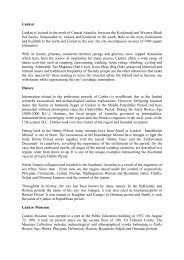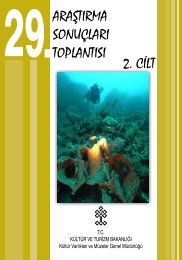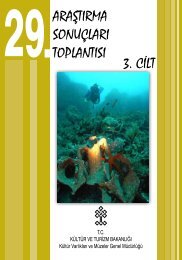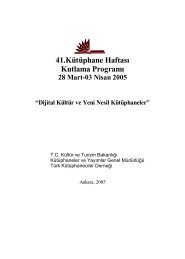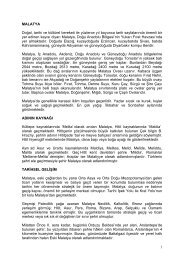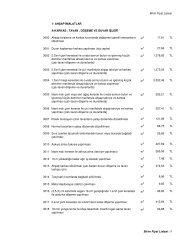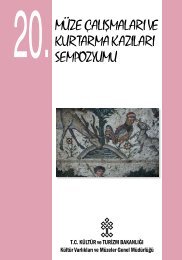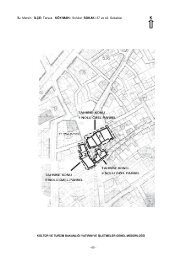Iznik brochure - Go Turkey
Iznik brochure - Go Turkey
Iznik brochure - Go Turkey
- No tags were found...
Create successful ePaper yourself
Turn your PDF publications into a flip-book with our unique Google optimized e-Paper software.
Identified with Turkish ceramics, this small, attractiveregion has managed to survive since the 4th centuryBC. Its location which is very close to the road linkingİstanbul to Anatolia, is an important source of its vitality.İznik is the city of Dionysus, <strong>Go</strong>d of Wine… Accordingto myth, Nicaea, who was the daughter of the River <strong>Go</strong>dSangarios (Sakarya River) and the <strong>Go</strong>ddess Cybele, tookan oath that she would never marry. She lived in a forestand liked hunting. One day, she met a shepherd calledHymnus who, when he saw Nicaea, fell in love with her.Nicaea, however, shot him with an arrow. Eros, the <strong>Go</strong>dof Love, was angered by her behaviour and turned tothe <strong>Go</strong>d of Wine, Dionysus, asking for his help to takevengeance upon her. But Dionysus also fell in love withNicaea when he caught sight of her bathing in the river.He feared that she would shoot him too, and added wineto the river from which Nicaea drank water. When shewas drunk, he seduced her. As soon as Nicaea realisedthat she was pregnant, she tried to kill herself, but obeyedDionysus and gave birth to his child. Dionysus, afterhis return from India, founded this city and named it‘Nicaea’, after his beloved.
Rich in legend, İznik has beenknown as Nicaea since ancienttimes. It appears that the region owesits present name to the pronunciation of the words‘Eis’ and ‘Nik’ part of the phrase, ‘Eis Ten Nikaieon’meaning ‘to Nicaea’ in Greek.Archaeological findings in the mounds of Karadin,Çiçekli, Yüğücek and Çakırca reveal that the historyof İznik dates back to the prehistoric period, around2500 B.C.Before the immigration of Thracian tribes in the7th century BC, the settlement in the area of today’sİznik was known as Helikare. In the 4th century, thissettlement became known as Antigoneia followingits renovation by the Phrygian <strong>Go</strong>vernor of theMacedonian Kingdom. After the death of Alexanderthe Great, Antigoneia was captured by Lysimachus,the ex-governor of Thrace, and its name was changedto Nicaea, which was ascribed to Lysimachus’wife Nike. Later in 293 BC, it was annexed to theBithynian Kingdom. In this period it was decoratedwith significant architectural structures. <strong>Go</strong>lden coinswere also minted in the city, which led to it beingknown thereafter as the ‘<strong>Go</strong>lden City’. The Romansbattled with the Bithynian Kingdom for many yearsand eventually captured the capital Nicaea, andreconstructed it, repairing the damage caused by theearthquake in 123 AD. Again in this period, the citywas surrounded by 4970 kilometre city walls including4 main and 12 subordinate gates.A very important centre for Christianity, İznik wasintroduced to Christianity through the efforts ofthe Apostle, St. Peter. All the prohibitions relatingto Christianity were abolished during the reign ofthe Emperor Constantine I. In the beginning of the
summer of 325, Nicaea had witnesseda very important event for Christianity:the 1st Ecumenical Council, which gatheredhere in İznik in the palace in the presence of theEmperor Constantine. One of the subjects discussedin the council was the disagreement in the church ofAlexandria over the nature of Christ. According to thethesis of an Alexandrian priest, Arius, Jesus Christ wasnot eternal, and was subordinate to <strong>Go</strong>d the Father.This thesis had found many followers in a short time;however, it had been opposed by the bishops. Afterlong debate in the Council, the thesis ‘Jesus Christ tobe of one substance with the <strong>Go</strong>d the Father’ foundacceptance, as it is still accepted today. The Councilformulated the Nicene Creed and 20 canons as well,as agreed on the date of Easter. İznik also bore witnessto the 7th Ecumenical Council in the Ayasofya Churchin 787. During the same period the prohibitions onpaintings and statues were removed thanks to the effortsof the Empress Irene.İznik served as the capital of both the Seljuks andByzantines. In 1331 it was captured by the Ottomanscommanded by Orhan Gazi, and in this period itbecame a centre of art, trade and culture. Some of thefamous Sufis like Davud-u Kayseri, Ebul Fadıl Musaand Eşrefoğlu Abdullah Rumi lived in this lovelydistrict and left many literary works behind them. Thefirst mosque, madrasa and soup kitchen belonging tothe Ottoman Period were all constructed in İznik. Inthe 14th, 15th and 16th centuries, İznik became animportant art centre and the world famous İznik tilesand ceramics were produced here.The historic architecturaltexture of the district is stillalive with its grid settlementplan which has remainedsince the Hellenistic Periodand monumental structuresfrom the Roman, Byzantineand Ottoman periods.
İZNİK MUSEUM(NİLÜFER HATUN SOUP KITCHEN)This important edifice, which today is a museum,was constructed by Sultan Murat I in memory of hismother, Nilüfer Hatun in 1388. Known as the firstsoup kitchen built with a reverse T-shaped plan, it isa fine example of Ottoman architecture. Its brick andstone work is rich and colourful, designed with threerows of brick and a row of stone. The building servedas a soup kitchen until the end of the 19th century; butit was largely destroyed during the Greek occupationin the Independence War. After having been restoredin 1960, the Nilüfer Hatun Soup Kitchen was openedto visitors as a museum.The Museum collection includes archaeological findsunearthed at the excavations of Ilıpınar, the theatreand İznik kilns together with other items found inİznik and the surrounding area.Greek, Roman, Byzantine and Ottoman worksincluding column capitals, sarcophagi, reliefs, ambos,steles, inscriptions, gargoyles, column tambours,baptismal fonts, baked clay sheets and Islamic gravestones are exhibited in the garden of the museum. Inthe main hall are prehistoric ceramics, Greek, Romanand Byzantine age ceramics, stone works, glass wares,coins, jewellery, kerosene lamps, and metal works.Byzantine and Ottoman ceramics, kiln equipment,manuscripts, tobacco, money, watches, bowls, gunsand rifles, ornaments, utensils, ethnographic artefacts,and Islamic coins are on display in the room leadingto the main hall.
AYASOFYA MUSEUMThis museum was once the church whichwitnessed the 7th Ecumenical Councilin 787 BC, a very important event forChristianity. It is located at the pointwhere the roads leading to the 4 main gatesin the district centre meet. The churchwas constructed by the Emperor Justinianover the ruins of the former church datingback to the 4th century. However, it wasdemolished after an earthquake in the11th century and rebuilt in the shape ofa basilica with three naves. Its colourfulmarble floor mosaics with geometricdesigns and frescoes depicting saints andapostles are all charming.Following the conquest of İznik by Orhan Gazi in 1331,this basilica shaped church was turned into a mosque.In the reign of Sultan Süleyman the Magnificent, itwas expanded with a minaret on the front and its wallswere decorated by the famous architect Sinan.YEŞİL MOSQUE(GREEN MOSQUE)Recognised as the symbol of İznik, the Yeşil Mosquetakes its name from the turquoise coloured İznik tilesand bricks of its minaret which are a fine reflectionof Seljuk minaret style in Ottoman art. Built by thearchitect Hacı Musa between 1378 and 1392 uponthe request of Halil Hayrettin Pasha, this mosque isundoubtedly the most magnificent of the single domedmosques of the Ottoman Period. Its unique minaretis on the right corner of the mosque. While its nichedisplays rich stone work, its body is covered with blueand green coloured tiles in zigzag mosaic style.HACI ÖZBEK MOSQUE(ÇARŞI MASJID)Hacı Özbek Mosque is the oldest Ottoman mosque inİznik, dating back to 1333. Built of hewn stone andbrick, this square planned mosque has no minaret. Itsdome has a diameter of 8 metres and is covered withroof tiles.MAHMUT ÇELEBİ MOSQUEMahmut Çelebi, one of the grandsons of HayrettinPasha had this mosque built in 1442. Located in thedistrict centre, the single domed mosque has a minaretwith brick bond work. It also includes an inscriptionover the entry gate.
ŞEYH KUDBETTİN MOSQUE AND TOMBClose to the Nilüfer Hatun Soup Kitchen,the Şeyh Kudbettin Mosque and theadjacent tomb for Sheik Kudbettin wereconstructed upon the request of İbrahimPasha, one of the viziers of Sultan Bayezidthe 2nd. This 15th century-mosque wasrestored to its original architectural form in2007.YAKUP ÇELEBİ DERVISH LODGE ANDTOMBThe dervish lodge was built in the 14thcentury by Yakup Çelebi who was theyounger brother of Yıldırım Bayezid. Thereis a single domed tomb in the garden.Contrary to common belief, the grave of Yakup Çelebiis not in this tomb but in the tomb of Murad the 1stin Bursa.Other tombs in İznik also include: Eşref-i RumîMosque and Tomb, Kırgızlar Tomb, Sarı Saltuk Tomb,Çandarlı Hayrettin Paşa Tomb, Çandarlı İbrahim PaşaTomb, Çandarlı Halil Paşa Tomb, Huysuzlar Tomb,Ahiveyn Sultan Tomb and Abdülvahap SancaktarıTomb.SÜLEYMAN PAŞA MADRASASüleyman Paşa Madrasa is the oldest in İznik which hassurvived to the present day. Orhan Gazi’s son SüleymanŞah had it built in 1332. Included in the category ofU-shaped Ottoman madrasas, it has 11 rooms and aclassroom. Its walls date back to the first half of the14th century whereas its dome dates from the secondhalf of the 15th century.HAGIOS TRYPHONOS CHURCHWith four columns, the Hagios Tryphonos Church hasa cross-shaped plan. Its wall technique and plan revealthat this church was a Byzantine work built in the 11thcentury.AYATRIFON CHURCHLocated on the road leading to the İstanbul Gate, thiscruciform planned church dates back to the 10th and12th centuries. The ruins show that the structure wasonce topped with a large dome and its floor was coveredwith very elaborate mosaics.
KOIMESIS CHURCHBishop Hyakinthos had this church built inthe 8th century. Supposed to have been a partof the Hyakinthos Monastery, the churchwas destroyed in the 1065 earthquake, butlater it was repaired and enlarged. Onlyits flooring mosaics and foundation havesurvived to the present.BÖCEK AYAZMASI (BAPTISTERY)(HOLY SPRING OF ORTHODOX GREEKS)Located near the Koimesis Church, thisbaptistery is a round structure with a waterspring at the centre of a quadrangularfountain. It is covered by a dome. Supposedto have been a part of the HyakinthosMonastery, the baptistery is under theground floor and reached by a staircase.UNDERGROUND GRAVE(HYPOGEUM)This underground grave, found in the Hesbekli locationof Elbeyli Village, is thought to have been built in the4th or 5th centuries AD. It is covered by a vault and itsceiling and walls are decorated with typical colourfulfrescoes of the early period of Christianity.BERBER ROCK MONUMENTAL TOMBErected in the memory of the King Prusias the 2nd ofBythnia, this monumental tomb dates back to the 2ndcentury BC, and is a significant example of Hellenisticart in İznik. Carved on a large rock piece in the foothills,the tomb with a triangular fronton is in the form of asarcophagus.DÖRT TEPELER TUMULUSThe tumulus is located within the graveyard of ElbeyliMunicipality. There are two monumental tombs in it.The first one is near the road and has a rectangular graveroom with a dromos (narrow passageway). On bothsides of this room are two stone seats. Built of whitemarble, the grave room in the other tomb has also adromos covered by rough stones and trees.
BEŞTAŞ(OBELISK)Also known as Nişantaşı and Dikilitaş,this grave monument is on the ancientRoman road. Its inscription in Greekreveals that the obelisk was built by C.Cassius Philiscus in the 1st century. It risesover a rectangular prismatic pedestal, andincludes five triangular prismatic stonesone over the other.CITY WALLSThe pentagon shaped city walls that surround İznikare 4970 metres in length. Although these citywalls were constructed in the Hellenistic era, theyhave lost all the characteristics peculiar to this era.Only the wall parts constructed in the Roman andByzantine periods have survived to the present. Inthe 8th century, the city walls were made higher andthe bastions were built by using the constructionmaterials brought from the theatre.HISTORIC GATESThe historic gates in İznik were actually constructedas triumphal arches in the reigns of the EmperorVespasianus (69–79) and Emperor Titus (79–81),and were restored to a large scale in the time ofEmperor Hadrian. The city walls were built byconnecting these arches to each other. Reflectingthe architectural technique and style of the RomanPeriod, the İstanbul, Lefke and Yenişehir gates stillstand splendid today, although the remaining gate,the Göl Gate is in ruins.THEATREThe ancient theatre spreading over a large area amidthe shores of the lake and the Yenişehir Gate wasconstructed between 111 and 112 during the reignof the Emperor Trajan. It was converted into a massgraveyard in the 13th century. The graveyard waslater replaced by the ceramic kilns. Only some partof the cavea (audience section) of the ancient theatrehave survived to the present day. It appears that itsstones were used as construction materials especiallyin the restoration of the city walls.
RÜSTEM PAŞA INNThis 16th century inn is thought to havebeen constructed by the great architectSinan in the name of Rüstem Pasha, whowas the grand vizier of Sultan Süleymanthe Magnificent. Today, it is unfortunatelyin ruins amidst the apartments with onlya part of its north and western walls stillstanding.İSMAİL BEY HAMAM(BATHHOUSE)İsmail Bey Hamam is located on the road leading tothe İstanbul Gate. With its interior design from the14th and 17th centuries, it is an elegant structure.Covered with a dome, it has a square plan including4 square spaces decorated with stucco work. It is alsocalled as Selçuk Hamam, Mescit Hamam and BeylerHamam.HACI HAMZA HAMAM(BATHHOUSE)Also known as the Murat II Hamam, this bathhousewas constructed in the 15th century. It includesseparate sections for women and men. The section formen is still in use today.MEYDAN HAMAM(BATHHOUSE)Meydan Hamam, one of the three historicallysignificant bathhouses in İznik, is also known as BüyükHamam. Located on Atatürk Street, this bathhousedates back to the end of the 14th century and the firsthalf of the 16th century.The stone wall technique used in the constructionincludes a brick bond course. The caldarium (hotroom) that is built of stucco work is attractive.
Involved in architecture during the first half of 3000BC, ceramics began to be used in Islamic architecturein the 9th century.The ceramic art of İznik flourished in the 13th centurywhen Seljuk architecture was at its peak. In thatperiod, the walls of many mosques, madrasas, tombsand palaces were decorated with elegant ceramics.Together with the Ottomans, ceramic art gained anew perspective in the 14th century. The Ottomanceramics continued the Seljuk tradition in techniqueand style but they are richer than the Seljuk ceramicsin terms of their colours and hues. The turquoise andgreen ceramics decorating the minaret of the İznikYeşil Mosque are an enchanting examples of Ottomanceramic art.Between the 15th and 17th centuries İznik becamean important centre for ceramic production. Historicsources confirm that ceramics on the walls of thepalaces and other historic buildings in İstanbul wereproduced here in İznik.İznik is also the centre of the ceramic works which areknown as Milet, Damascus and Rhodes. Floral motifssuch as tulip, hyacinth, pomegranate and carnation areassociated with the İznik ceramics which also depicthuman and animal figures and ships. Their colours aremostly blue, turquoise, green and red.
An indispensable part of the almost 8000 year old cuisineculture of humankind, olives are grown abundantly in ourcountry. Covering the 10 % of the world olive production,<strong>Turkey</strong> ranks the 1st in the production of black olives,the 2nd in the production of table olive and the 4th inthe production of olive oil. İznik’s contribution to theserates is undoubtedly very important since it is one of thelargest olive production centres in <strong>Turkey</strong>.
Besides its world famous ceramics, İznik also provesits worth with traditional handicrafts. Silk carpets ofthe Sansarak Village, rugs of the Derbent Village andembroideries of the Müşküle Village are all hand madeand quite attractive for visitors.Konak and Köylü bazaars set up on Wednesdays are idealshopping areas in İznik.
The district has a rich regional cuisine. Almost all dishes,cooked from vegetable and meat in <strong>Turkey</strong>, can also betasted in the district. On the Lake side, delicious fishdishes such as soups and grills made from carp, sheathfish cooked on a skewer and sheath fish stew are all worthtrying.
Located on a fertileplain on the eastern shores ofLake İznik, İznik offers irresistiblespots for nature lovers with its fresh airand verdant environment. The Köristan, Avdan andMüşküle Plateaux in Katırlı Mountains and Hacı OsmanPlateau in Samanlı Mountains are popular for campingwhereas the Sansarak Canyon with its 8 km long trailnear the Sansarak Village is excellent for nature walking.Among activities to enjoy the region are also grass skiingand photo safari tours which offer the beauty of a verdantlandscape.Being the 5th biggest natural lake in <strong>Turkey</strong>, Lake İznikwith its crystal clear waters offers the opportunity toexperience the excitement of water sports such as sailing,surfing, canoeing, rowing, jet skiing, water skiing as wellas fishing and swimming throughout the year. Onthe other side, its southern shores areperfect for camping in a tranquilatmosphere.
The Liberation of İznik November 28Hıdrellez Celebrations(Beginning of Summer)The first week of MayLyric Festival in the Lake AreaPublic Training FestivitiesThe first week of JuneThe first week of JuneElbeyli MunicipalitySpring Festivitiesİznik FairThe first or second week of MayOctober 5-10
There are regular bus services to İznik from all over thecountry while the nearest airport is in Bursa.
Mild climatic conditions are dominant in the districtwith rainy winters and hot summers which are also rainyenough to prevent drought.
TemperatureRelative HumidityJan. Feb. Mar. Apr. May June4.7 5.3 8.3 11.4 14.1 19.667.4 67.9 67.9 67.9 69.3 73.6TemperatureRelative HumidityJuly Aug. Sep. Oct. Nov. Dec.22.1 21.4 18.4 17.4 9.9 10.672.2 73.3 74.5 74.7 68.8 68.5
Bursa City Directorate of Culture and TourismSarı Köşk Osmangazi Cad. No:6 TophaneTel: + 90 (224) 220 99 26 - 220 70 19Fax: + 90 (224) 220 42 51İznik Tourist Information OfficeKılıçarslan Cad. Belediye Hizmet BinasıTel: + 90 (224) 757 19 33 - 757 14 54Fax: + 90 (224) 757 19 33İznik Museum (Nilüfer Hatun Soup Kitchen)Yeşil Cami MahallesiTel: + 90 (224) 757 10 27(Open every day except Monday)İznik Ayasofya Museumİznik City CentreTel: + 90 (224) 757 10 10(Open every day except Monday)İznik District Administration Office + 90 (224) 757 10 01Municipality + 90 (224) 757 10 10Tourism Police + 90 (224) 757 10 52Bursa Yenişehir Airport + 90 (224) 781 81 81Post Office + 90 (224) 757 19 70Bus Terminal + 90 (224) 757 81 90Hospital + 90 (224) 757 75 80Police + 90 (224) 757 10 52Gendarme + 90 (224) 757 10 05Fire 110Medical Emergency 112Police 155Gendarme 156
Visiting the Ayasofya Museum which once witnessed the7th Ecumenical Council,Walking around the İznik city walls, historic gates,tumuli and grave monuments,Seeing the Yeşil Mosque’s unique minaret decorated withturquoise coloured İznik Ceramics,Tasting delicious fish dishes,Buying İznik Ceramics…
The world’s cultural heritage is like a big puzzle.Each monument, each object, is an irreplaceable partof the overall picture which gives us insight into ourorigins, our development and our lives today. It helpsus to understand and appreciate other cultures. Eachdiscovery, each new interpretation adds to the puzzleand makes the picture clearer. We must ensure theprotection of every single piece today, so that futuregenerations may have the opportunities to enjoy thepuzzle.Many people are not aware that our cultural heritage isunder stress from natural disasters such as earthquakesand floods, and from slower acting processes such aspollution or human actions. Even the most innocentgestures such as collecting ancient pieces of potteryor mosaics as souvenirs have a destructive impact ifrepeated by thousands. Touching an object of stone,metal or textile leaves traces of grease, acid or sweaton its surface. Climbing a monument wears down thestructure underneath and can dismantle it. Writing orengraving names inflicts permanent damage. Strollingaround narrow crowded places with bulky bags orbackpacks might knock over an object or scratch amural painting and ruin it. There are countless waysin which one can unknowingly contribute to thedestruction of cultural heritage.In 2020 there will be 1.6 billion visitors per yearworldwide. Let us raise awareness of this issue so thatwe may join together to protect and enjoy the diversityand richness of our cultural heritage.International Organization for Conservation ofCultural Heritage (ICCROM)
Information
REPUBLIC OF TURKEYMINISTRY OF CULTURE AND TOURISMGeneral Directorate of Information©www.kulturturizm.gov.trwww.goturkey.comFront CoverYeşil MosqueBack CoverAyasofya MuseumText Compiled byCengiz Ekici, Ayşe BaliContent Updated byMustafa YılmazTranslationN.İ. Gamze Sağdinç, Aygül ÖzdemirGraphic Design - DrawingSeyfi GÜLOĞLUseyfi guloglu@gmail.com - 0 542 796 31 20PhotosArchive of the Ministry of Culture and Tourism,Osman Aziz Yeşil, Servet Uygun, Sıtkı Fırat,İzzet Keribar, İbrahim Zaman, C.Refik Ongan,Fikret Özkaplan, Uluç Özgüven,Bursa <strong>Go</strong>vernorship,İznik District <strong>Go</strong>vernorship.Printed byBaşak Matbaacılık ve Tanıtım Hiz. Ltd. Şti.Tel: 0312 397 16 17 Fax: 0312 397 03 07Ankara 2011For Free Distribution


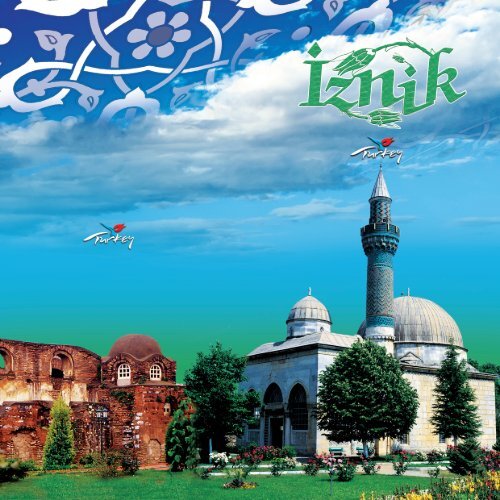
![11. Türk Arkeoloji ve Etnografya Dergisi [2011] - kulturvarliklari.gov.tr](https://img.yumpu.com/50970752/1/182x260/11-turk-arkeoloji-ve-etnografya-dergisi-2011-kulturvarliklarigovtr.jpg?quality=85)
